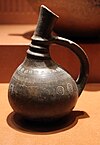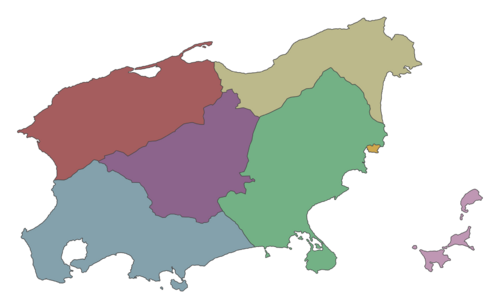Suhala: Difference between revisions
| (One intermediate revision by the same user not shown) | |||
| Line 128: | Line 128: | ||
===Solarian Period=== | ===Solarian Period=== | ||
By 200 BCE, the collapse of Piraean power had lead to no mainland Piraean states holding land in Suhala. The island remained fragmented, a patchwork of various cultures. Around 170 BCE, the Nihashi city-state of Nurraşe invaded much of the east and south of the island, uniting the region but being unable to make inroads west. A period of centralization began, with the expansion of small trade roads, and the revival of Suhalan trade. This growth attracted the attention of the Solarians, who initially worked with the Nurraşe in order to keep trade routes open to Coius. Solarian expansion would soon reach Suhala, and in March of 113 the first Solarian armies landed in northeastern Suhala, on pretext of stopping pirates. The Solarians would expand across the island and eventually conquered the Nurraşe after it was discovered that the king of the Nurraşe had been aiding rebels in Solarian Suhala. | |||
===Verliquoian Period=== | ===Verliquoian Period=== | ||
| Line 156: | Line 156: | ||
===Administrative Divisions=== | ===Administrative Divisions=== | ||
{| class="wikitable" cellpadding="0" cellspacing="0" style="margin: 1em {{{1}}}em {{{1}}}em {{{1}}}em;" border="1" | |||
| align="center" style="background:#f0f0f0;"|'''Province''' | |||
| align="center" style="background:#f0f0f0;"|'''Population <br> (Estimated)''' | |||
| align="center" style="background:#f0f0f0;"|'''Magistrate <br> (Kazi)''' | |||
| align="center" style="background:#f0f0f0;"| | |||
| align="center" style="background:#f0f0f0;"|'''Governing party''' | |||
| align="center" style="background:#f0f0f0;"|'''Location''' | |||
|- | |||
| [[Brethoriana|Breśoriana]] | |||
| 1,354,000 | |||
||[[Thibaut Du Toit]] | |||
| style="background-color:#4D24B3"| | |||
| [[Sotirian Democratic Front]] | |||
|! rowspan="11" style="width:4em; background:#fff;"|{{Suhala regional labelled map|float=center}} | |||
|- | |||
| [[Montearce]] | |||
| 683,000 | |||
||[[Justin Manaudou]] | |||
| style="background-color:#2A298C"| | |||
| [[Party for Liberty]] | |||
|- | |||
| [[Bignugla]] | |||
| 984,000 | |||
||[[Tristan Garreau]] | |||
| style="background-color:#DD6262"| | |||
| [[Sotirian Union for Progress]] | |||
|- | |||
| [[Azachu|Azaçu]] | |||
| 1,113,000 | |||
||[[Xavier Delon]] | |||
| style="background-color:#DD6262"| | |||
| [[Sotirian Union for Progress]] | |||
|- | |||
| [[Nurreşa]] | |||
| 1,383,000 | |||
||[[Fernand Bruneau]] | |||
| style="background-color:#DD6262"| | |||
| [[Sotirian Union for Progress]] | |||
|- | |||
| [[Nepitagara]] | |||
| 1,621,000 | |||
||[[Constantin Béliveau]] | |||
| style="background-color:#DD6262"| | |||
| [[Sotirian Union for Progress]] | |||
|- | |||
| [[Emessan Archipelago|Emessa]] | |||
| 186,000 | |||
||[[Éric Lazard]] | |||
| style="background-color:#4D24B3"| | |||
| [[Sotirian Democratic Front]] | |||
|} | |||
==Economy== | ==Economy== | ||
Latest revision as of 17:19, 23 December 2023
This article is incomplete because it is pending further input from participants, or it is a work-in-progress by one author. Please comment on this article's talk page to share your input, comments and questions. Note: To contribute to this article, you may need to seek help from the author(s) of this page. |
Democratic Republic of Suhala Refufijqpe Pofujare Suxare | |
|---|---|
| Motto: in Lipertar Uniśu "United in Liberty" | |
| Capital and largest city | Nepitagara |
| Official languages | Suxaran |
| Recognised regional languages | Atudite Vespasian Rahelian Atudo-Suxaran |
| Ethnic groups (2020) | Suhalan (74.1%)
Atudite (11.1%) Rahelian (10.2%) Etrurian (3.2%) Other (1.4%) |
| Demonym(s) | Suhalan |
| Government | Unitary parliamentary republic |
• Premier | Omfroj Aukiśśinu |
• President | Ormiśśu Parfuśu |
| Senaśu Suxare "Senate of Suhala" | |
| Ćamfra Pofujo "Camber of the People" | |
| History | |
• Povelian Domnion | 1331-1784 |
• Colonization by Etruria | 1817 |
• Suxaran Independence | 1948 |
| Area | |
• | 22,487 km2 (8,682 sq mi) |
• Water (%) | 3.1 |
| Population | |
• Estimate | 7,325,250 |
• 2020 census | |
• Density | 325.7/km2 (843.6/sq mi) |
| GDP (PPP) | 2020 estimate |
• Total | |
• Per capita | |
| GDP (nominal) | 2020 estimate |
• Total | |
• Per capita | |
| Gini (2020) | low |
| HDI (2020) | very high |
| Currency | Suhalan Lifra (SHL) |
| Date format | dd.mm.yyyy |
| Driving side | right |
| Internet TLD | .sl |
Suhala (/suhɑːlə/ soo-HAH-lə), officially the Democratic Republic of Suhala (Suhalan: Refufijqpe Pofujare Suxare [rɛfuvijk͡pɛ pɔfularɛ suxarɛ]) is a transcontinental sovereign nation located in the Solarian Sea, between Euclea and Coius. It shares maritime borders with Tsabara to its south and east, Paretia to its north, and Etruria to its west. Suhala has a population of 7.325 million people and is a very urbanized nation, with its largest city being the capital Nepitagara.
The homeland of the Suhalan people, Suhala is a majority Sotirian country, with significant Irfan and Atudite minorities. Suhala's position in the Aurean Straits has made it very important throughout history, and the island has been inhabited since the paleolithic era. The earliest peoples in Suhala are only known as the Proto-Suhalans, whom were eventually supplanted on the south of the island by the Nimenes, whom came into conflict with the Piraeans. Suhala was part of the Solarian Empire for around 5 centuries, and in the middle ages was part of the Verliquoian empire and the Second Heavenly Dominion. In 1817, Etruria took control of the island, which would remain under Etrurian control until the end of the Solarian War. As part of the conditions, Suhala became a CN mandate for 2 years and became an independent state in 1948. From the early 60s to the mid-80s, Suhala was under the control of the socialist party the LRS, which eventually stepped down in 1985 following nationwide protests. The country would liberalize and push for admittance into the Euclean Community, however a corruption scandal in 2015 that brought down the largest establishment party and Etruria pulling out of its plan to join the EC in 2016 lead to the collapse of the initiative.
Today, Suhala is a unitary parliamentary republic with a highly developed economy. It is a member of the Community of Nations, the International Trade Organization, the Aurean Forum, and the Association of Solarian Nations.
Etymology
The word Suhala comes from an Estmerization of the Suhalan name for the country, Suxara, which derives from the Pardari word šakar meaning "sugar". This was likely adopted due to the fact that at the time of the initial Irfanic invasions, one of the islands main agricultural exports was sugar.
History
Prehistory
The first modern humans likely arrived in Suhala around 65 KYA, coming from northern Coius. They quickly displaced all other hominid species, and by around 9,000 BCE the first farming communities had begun to emerge. Suhala has multiple prominent neolithic sites, including the Village at Nataly, where various stone tools have been found, as well as evidence of the domestication of animals like pigs and sheep.
Antiquity
By around 3000 BCE, bronze metallurgy had spread to Suhala, and various Suhalan city-states formed the Nahashi civilization, named for the Nahashi, their bronze city centres.They posessed a complex system of organization, and are speculated to have mostly been theocracies. Clusters of city-states developed distinct cultures due to their relative isolation, while smaller villages in the center also drifted culturally. It is speculated that their religion featured veneration of animal deities, with various forms of art depicting bull, ram, and pig-headed deities, as well as a focus on water, due to the heavy presence of wells at religious sites. Large amounts of decorated vessels have been found, and form an integral part of the modern understanding of Nahashi culture.
Between 2500-2800 BCE the first records of the Nimenese civilization emerges, with Nimenese city-states supplanting Nahashi ones. It's speculated that the Nimenese originally lived in the interior of the island, before invading the city-states of the south. By about 2000 BCE, the island was divided between Nimenese city-states in the south and Nihashi ones in the north. An amply supply of copper, wood, tin, fertile soil, control of trade routes, and the presence of exotic textiles and dyes turned Suhala into a hub of commerce, and the Nimenese quickly became famed traders. Nimenese city-states established colonies abroad, with marks of Nimene presence, such as temple ruins, settlements, goods, and writing have been found as far as Etruria, Piraea, and Tsabara. The Nimenes developed the Nimenean alphabet, which became the ancestor of the Solarian, Piraean, Soravian, Apsinithian, Satrian, and many other scripts. Around 800 BCE, the Nimenese civilization began a long period of decline, and much of Suhala fell under the control of Piraean states, including most of the west of the island. A mosaic of Nihashi, Nimenese, and Piraean city-states developed on the island, often warring.
Solarian Period
By 200 BCE, the collapse of Piraean power had lead to no mainland Piraean states holding land in Suhala. The island remained fragmented, a patchwork of various cultures. Around 170 BCE, the Nihashi city-state of Nurraşe invaded much of the east and south of the island, uniting the region but being unable to make inroads west. A period of centralization began, with the expansion of small trade roads, and the revival of Suhalan trade. This growth attracted the attention of the Solarians, who initially worked with the Nurraşe in order to keep trade routes open to Coius. Solarian expansion would soon reach Suhala, and in March of 113 the first Solarian armies landed in northeastern Suhala, on pretext of stopping pirates. The Solarians would expand across the island and eventually conquered the Nurraşe after it was discovered that the king of the Nurraşe had been aiding rebels in Solarian Suhala.
Verliquoian Period
Kazi Period
Povelian Rule
Etrurian Colonization
Independence
Modern Day
Geography
Topography
Climate
Biodiversity
Government and Politics
Government
Law
Administrative Divisions
| Province | Population (Estimated) |
Magistrate (Kazi) |
Governing party | Location | |
| Breśoriana | 1,354,000 | Thibaut Du Toit | Sotirian Democratic Front | ||
| Montearce | 683,000 | Justin Manaudou | Party for Liberty | ||
| Bignugla | 984,000 | Tristan Garreau | Sotirian Union for Progress | ||
| Azaçu | 1,113,000 | Xavier Delon | Sotirian Union for Progress | ||
| Nurreşa | 1,383,000 | Fernand Bruneau | Sotirian Union for Progress | ||
| Nepitagara | 1,621,000 | Constantin Béliveau | Sotirian Union for Progress | ||
| Emessa | 186,000 | Éric Lazard | Sotirian Democratic Front |



